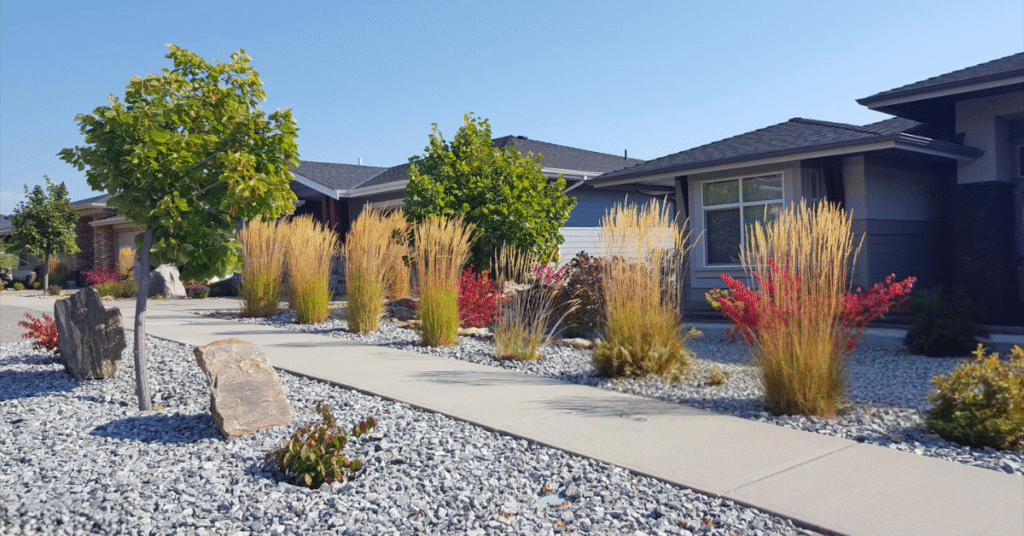I’m a landscape design contractor with Intu Nature Landscape Associates. I help business owners rethink commercial landscaping in San Diego by moving away from turf toward stunning drought‑tolerant planters, boulders, and cobbles. In this blog I’ll share why this shift makes financial and environmental sense, how I design it, what benefits clients see, and how it all comes together in San Diego’s climate.
Table of Contents
- Why ditch turf in commercial landscaping
- The power of drought‑tolerant planters and hardscape
- Real data: water & cost savings
- My design approach using boulders, cobbles, plants
- A few friendly quirks and tips
- People also ask (FAQs)
Why ditch turf in commercial landscaping
I’ve seen many commercial clients in San Diego complaining about high water bills and constant turf mowing. Turf uses far more water than drought‑tolerant landscaping. According to the Nevada Water Authority, every 15,000 sq ft of turf removed can save about 825,000 gallons of water per year. According to a source, the Pacific Institute estimates that replacing turf with climate‑appropriate plants reduces landscape water use by 70 % to 80 %. That means less turf, less watering, and fewer headaches.
The power of drought‑tolerant planters and hardscape
Instead of wide swaths of turf, I create zones with planters containing native or adaptive drought‑tolerant plants, mixed with boulders and cobbles for visual interest. Xeriscaping-style landscapes can cut water use by up to 60 % compared to lawn landscapes. These plants endure San Diego’s dry summers with minimal irrigation, resist pests, need less fertilizer, and almost no mowing. Mulch, rock groundcover, and drip irrigation make maintenance quick and easy.
Real data: water & cost savings
Here’s how the numbers play out:
- Water savings: If turf covers 10,000 sq ft on your commercial site, removing it could save roughly 550,000 to 660,000 gallons annually (based on 825,000 gal per 15,000 sq ft).( source: Intu Nature, PRIDE Industries)
- Cost savings: Xeriscaping maintenance costs fall about 55 % compared with traditional turf landscapes; installation costs also drop by around 57 %
- Rebates: In Southern California, some water agencies offer rebates of $3 to $4 per square foot removed
So the financial wins stack up: lower utility bills, reduced upkeep, plus potential rebates.
My Design Approach Using Boulders, Cobbles, Plants
Here’s how I usually design commercial landscaping for San Diego clients:
- Site survey and layout – I map existing turf and shade patterns.
- Zone by water needs – I group plants by irrigation need for efficiency.
- Hardscape features – I place boulders and cobbles to anchor visual interest and reduce planted area.
- Plant palette – I select drought‑tolerant shrubs, succulents, and native perennials suited to San Diego’s climate
- Irrigation plan – I use drip and smart water-sense certified systems to minimize waste
- Mulch and finishing – Mulch helps retain moisture, prevent weeds, and soften rock beds.
Savings comparison: turf vs. drought‑tolerant landscaping
| Feature | Turf landscape | Drought‑tolerant planters + hardscape |
| Annual water use (10,000 sq ft) | ~600,000 gal | ~120,000 gal (‑80 %) |
| Maintenance labor | Weekly mowing, fertilizing | Occasional weeding, minimal upkeep |
| Annual maintenance cost | Baseline = 100 % | ~45 % of turf cost (≈ ‑55 %) |
| Rebates available | None | $3–4 per sq ft turf removal |
| Visual impact | Uniform green turf | Rich texture, color, boulders, and drought plants |
A few friendly quirks and tips
I like to joke: turf is like that needy friend who never stops talking — mowing, watering, fertilizing. But drought‑tolerant design is more like a chill companion: no fuss, only compliments. I’ll often say to clients, “Let the boulders talk.” They add structure and durable style. And cobbles? They create walking paths or planting islands that feel intentional and tidy.
Choosing the right plants is important. Succulents and native flowers give color all year, and heavy rocks stay in place and make the landscape feel solid. Most clients smile when they hear “install once, enjoy forever.” And yes, rebates are serious money—so I’ll usually help with paperwork.
I hope this helps you think about commercial landscaping a bit differently. I’ve walked clients through dozens of conversions from turf to beautiful drought‑tolerant planters with cobbles and boulders—and the feedback is always, “Why didn’t we do this sooner?” I’d love to help you too. Just reach out to Intu Nature—I’ll be the guy who turns turf trouble into rock‑solid beauty.
People also ask
What is commercial landscaping San Diego style?
We focus on drought‑tolerant design tailored for businesses in San Diego: replacing turf with planters, boulders, cobbles, native plants, and smart irrigation. This approach keeps properties attractive while staying water‑wise all year.
How much water can I save by removing turf?
You could save about 70–80 % of landscape water—or roughly 550,000–660,000 gallons per year for 10,000 sq ft of turf saved. Over time, this also reduces stress on local water supplies and helps the environment.
Will this landscaping look attractive without turf?
Absolutely. By mixing textures—succulents, shrubs, gravel, boulders, cobbles—it creates visual interest and lush appeal fabric even without green grass. Visitors often notice the unique design and remember the property for its charm.
Do rebates exist for turf replacement?
Yes. In Southern California agencies offer $3 to $4 per square foot removed, saving clients thousands on installation. This rebate can pay for a large part of the new drought‑tolerant project.
Is maintenance easier than with turf?
Definitely. You eliminate mowing, frequent watering, fertilizer, pesticides—so annual effort drops by more than 50 %. This frees up maintenance crews to focus on simple touch‑ups instead of constant turf care.
Can I still have seating areas or outdoor amenities?
Sure. Cobble patios, planter borders, seating boulders—they all integrate seamlessly into my design to support usability while staying low‑water.



